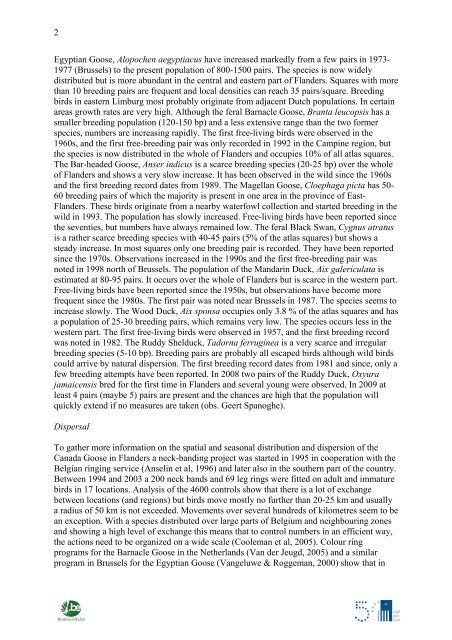Science Facing Aliens - Invasive Alien Species in Belgium - Belgian ...
Science Facing Aliens - Invasive Alien Species in Belgium - Belgian ...
Science Facing Aliens - Invasive Alien Species in Belgium - Belgian ...
Create successful ePaper yourself
Turn your PDF publications into a flip-book with our unique Google optimized e-Paper software.
2<br />
Egyptian Goose, Alopochen aegyptiacus have <strong>in</strong>creased markedly from a few pairs <strong>in</strong> 1973-<br />
1977 (Brussels) to the present population of 800-1500 pairs. The species is now widely<br />
distributed but is more abundant <strong>in</strong> the central and eastern part of Flanders. Squares with more<br />
than 10 breed<strong>in</strong>g pairs are frequent and local densities can reach 35 pairs/square. Breed<strong>in</strong>g<br />
birds <strong>in</strong> eastern Limburg most probably orig<strong>in</strong>ate from adjacent Dutch populations. In certa<strong>in</strong><br />
areas growth rates are very high. Although the feral Barnacle Goose, Branta leucopsis has a<br />
smaller breed<strong>in</strong>g population (120-150 bp) and a less extensive range than the two former<br />
species, numbers are <strong>in</strong>creas<strong>in</strong>g rapidly. The first free-liv<strong>in</strong>g birds were observed <strong>in</strong> the<br />
1960s, and the first free-breed<strong>in</strong>g pair was only recorded <strong>in</strong> 1992 <strong>in</strong> the Camp<strong>in</strong>e region, but<br />
the species is now distributed <strong>in</strong> the whole of Flanders and occupies 10% of all atlas squares.<br />
The Bar-headed Goose, Anser <strong>in</strong>dicus is a scarce breed<strong>in</strong>g species (20-25 bp) over the whole<br />
of Flanders and shows a very slow <strong>in</strong>crease. It has been observed <strong>in</strong> the wild s<strong>in</strong>ce the 1960s<br />
and the first breed<strong>in</strong>g record dates from 1989. The Magellan Goose, Cloephaga picta has 50-<br />
60 breed<strong>in</strong>g pairs of which the majority is present <strong>in</strong> one area <strong>in</strong> the prov<strong>in</strong>ce of East-<br />
Flanders. These birds orig<strong>in</strong>ate from a nearby waterfowl collection and started breed<strong>in</strong>g <strong>in</strong> the<br />
wild <strong>in</strong> 1993. The population has slowly <strong>in</strong>creased. Free-liv<strong>in</strong>g birds have been reported s<strong>in</strong>ce<br />
the seventies, but numbers have always rema<strong>in</strong>ed low. The feral Black Swan, Cygnus atratus<br />
is a rather scarce breed<strong>in</strong>g species with 40-45 pairs (5% of the atlas squares) but shows a<br />
steady <strong>in</strong>crease. In most squares only one breed<strong>in</strong>g pair is recorded. They have been reported<br />
s<strong>in</strong>ce the 1970s. Observations <strong>in</strong>creased <strong>in</strong> the 1990s and the first free-breed<strong>in</strong>g pair was<br />
noted <strong>in</strong> 1998 north of Brussels. The population of the Mandar<strong>in</strong> Duck, Aix galericulata is<br />
estimated at 80-95 pairs. It occurs over the whole of Flanders but is scarce <strong>in</strong> the western part.<br />
Free-liv<strong>in</strong>g birds have been reported s<strong>in</strong>ce the 1950s, but observations have become more<br />
frequent s<strong>in</strong>ce the 1980s. The first pair was noted near Brussels <strong>in</strong> 1987. The species seems to<br />
<strong>in</strong>crease slowly. The Wood Duck, Aix sponsa occupies only 3.8 % of the atlas squares and has<br />
a population of 25-30 breed<strong>in</strong>g pairs, which rema<strong>in</strong>s very low. The species occurs less <strong>in</strong> the<br />
western part. The first free-liv<strong>in</strong>g birds were observed <strong>in</strong> 1957, and the first breed<strong>in</strong>g record<br />
was noted <strong>in</strong> 1982. The Ruddy Shelduck, Tadorna ferrug<strong>in</strong>ea is a very scarce and irregular<br />
breed<strong>in</strong>g species (5-10 bp). Breed<strong>in</strong>g pairs are probably all escaped birds although wild birds<br />
could arrive by natural dispersion. The first breed<strong>in</strong>g record dates from 1981 and s<strong>in</strong>ce, only a<br />
few breed<strong>in</strong>g attempts have been reported. In 2008 two pairs of the Ruddy Duck, Oxyura<br />
jamaicensis bred for the first time <strong>in</strong> Flanders and several young were observed. In 2009 at<br />
least 4 pairs (maybe 5) pairs are present and the chances are high that the population will<br />
quickly extend if no measures are taken (obs. Geert Spanoghe).<br />
Dispersal<br />
To gather more <strong>in</strong>formation on the spatial and seasonal distribution and dispersion of the<br />
Canada Goose <strong>in</strong> Flanders a neck-band<strong>in</strong>g project was started <strong>in</strong> 1995 <strong>in</strong> cooperation with the<br />
<strong>Belgian</strong> r<strong>in</strong>g<strong>in</strong>g service (Ansel<strong>in</strong> et al, 1996) and later also <strong>in</strong> the southern part of the country.<br />
Between 1994 and 2003 a 200 neck bands and 69 leg r<strong>in</strong>gs were fitted on adult and immature<br />
birds <strong>in</strong> 17 locations. Analysis of the 4600 controls show that there is a lot of exchange<br />
between locations (and regions) but birds move mostly no further than 20-25 km and usually<br />
a radius of 50 km is not exceeded. Movements over several hundreds of kilometres seem to be<br />
an exception. With a species distributed over large parts of <strong>Belgium</strong> and neighbour<strong>in</strong>g zones<br />
and show<strong>in</strong>g a high level of exchange this means that to control numbers <strong>in</strong> an efficient way,<br />
the actions need to be organized on a wide scale (Cooleman et al, 2005). Colour r<strong>in</strong>g<br />
programs for the Barnacle Goose <strong>in</strong> the Netherlands (Van der Jeugd, 2005) and a similar<br />
program <strong>in</strong> Brussels for the Egyptian Goose (Vangeluwe & Roggeman, 2000) show that <strong>in</strong>


